Tillage 2023: Kverneland, Kuhn and KRM launch new kit
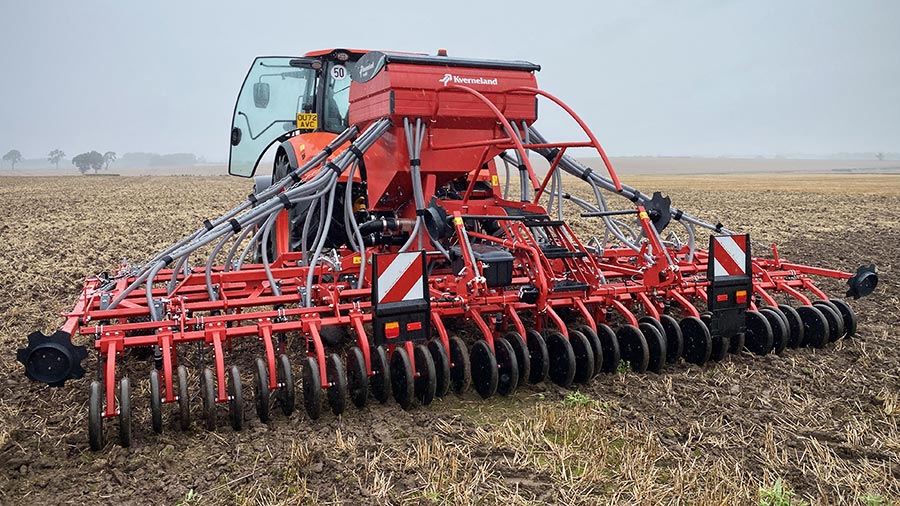 Kverneland TS drill © MAG/Oliver Mark
Kverneland TS drill © MAG/Oliver Mark Persistent rain at this year’s Tillage-Live event in Warwickshire gave the hardy souls who braved it a good chance to see how the latest cultivators and drills perform in sticky conditions.
Oliver Mark picks out some highlights.
See also: Direct drills revisited: Horsch Avatar 6.16 SD
Kverneland TS Drill
A new low-disturbance, narrow-tine version of Kverneland’s long-serving TS gives buyers the option of working directly into either stubble or standing cover crops.
The lightweight drill carries a set of straight 15mm-wide points, rather than the 55mm band-sowing boots on the existing model.
These are spaced at either 125mm or 150mm and each has its own 50kg-rated sprung break-back system.
Seed is fed from the single 1,700-litre hopper via a hydraulically driven fan air stream to the coulters.
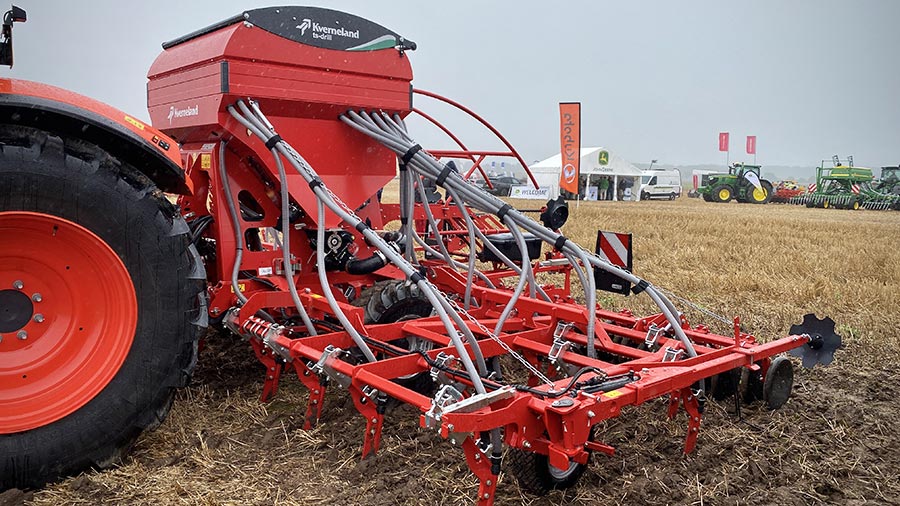
Kverneland TS drill © MAG/Oliver Mark
Finger harrows then ensure it is covered with soil and, as an option, press wheels can be specced at the back to improve contact with the soil.
These can be wound out of work when the ground is particularly wet and sticky to save them getting clarted up.
There’s also the option of fitting a clod board at the front to break up lumps ahead of the tines.
Though it’s not currently an option, KV is looking at offering the TS in combination with an F Drill front hopper, which will allow owners to lay fertiliser in the same pass.
Width options are 4.8m, 5m, 5.6m and 6m, with the list price of the latter starting at about £40,000.
Pottinger Rotocare V 12400
One machine undoubtedly ill-suited to wet weather is Pottinger’s Rotocare V rotary hoe.
The implement is designed for high-speed operation in dry conditions, with the spoon-like hooked fingers prising weakly rooted weeds from the soil with no impact on well-established crops.
Recommended working speed is upwards of 20kph – potentially to 30kph – to ensure an effective flicking action, so work rates of 22ha/hour are possible with the 12.4m V 12400 model that was on show.
According to the company, the 500mm under-frame clearance means it can work in crops up to 30cm tall, allowing several passes to be made each season, provided conditions allow.
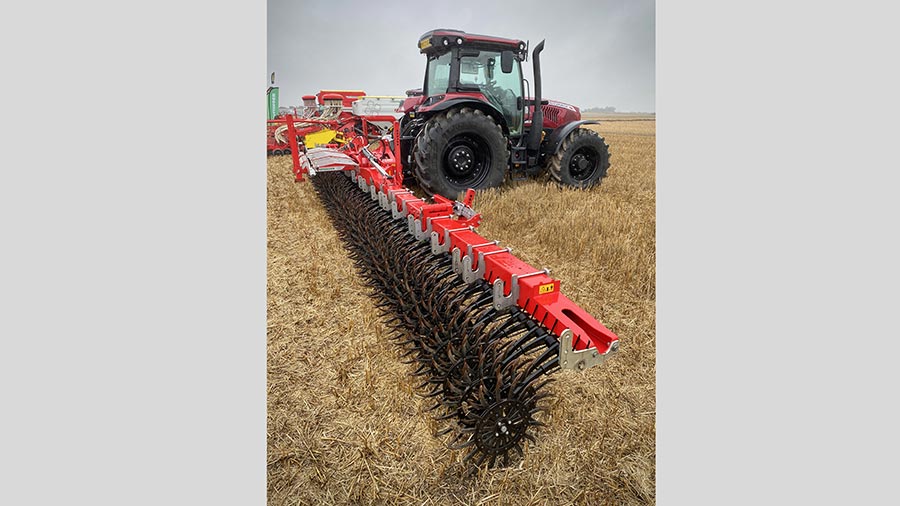
Pottinger Rotocare © MAG/Oliver Mark
It has obvious appeal as a mechanical weed control tool in organic systems, but it may also benefit conventional growers in supplementing a herbicide programme to reduce chemical costs.
As well as hoeing in cereals, sugar beet and maize crops, the Rotocare can be used to encourage a flush of weeds on post-harvest stubbles or to break the crust of spring ground, crumbling and aerating the top layer to improve surface drainage.
Working depth of the spring-loaded stars is set via the jockey wheels, to a maximum of about 40mm, while pitch – and therefore aggressivity – can be altered on the tractor’s top link.
It’s also possible to lift some of the 140 row units out of work to widen the standard 89mm row spacing.
The range currently includes a 6.6m version with 74 star wheels, an 8m with 90, and the aforementioned 12.4m.
However, an 18m model is coming next year and a 24m is apparently in the works – which may have more appeal, given it will allow those on 24m tramlines to stick to established wheelings.
The V 12400 needs about 160hp up front and has a list price of about £65,000. That figure is likely to drop to nearer £45,000 once dealer discounts are accounted for.
KRM Falc 3000
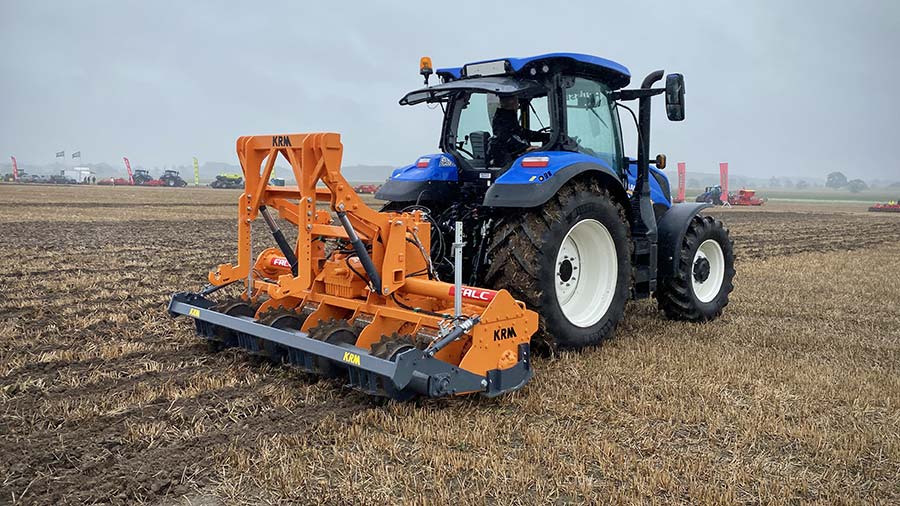
KRM Falc 3000 © MAG/Oliver Mark
Yorkshire-based KRM has added to its range of strip-till cultivators with the Falc 3000.
The Italian-made implement is designed to reduce unnecessary soil disturbance during primary cultivations – and the associated costs of horsepower, fuel and wearing metal – by only working the relatively narrow bands in which the following crop is to be drilled.
But unlike the combination of trash-cutting discs and deep-working legs of the Carre Inro, KRM’s other offering in this field, Falc’s 3000 is a powered implement.
As such, the front row of hard-wearing ripper tines is followed by pto-powered rotovator units that work to a depth of between 150mm and 250mm. These rows are then consolidated by a segmented roller.
The result is a fine seed-bed, says KRM, giving the benefit of a traditional tillage regime while leaving up to 70% of the soil surface untouched.
It also allows air into the crop row to encourage faster drying and warming, which should hasten germination and crop growth.
Options include a solid or liquid fertiliser kit and a rear linkage to carry a precision drill to complete all establishment work in a single pass.
There are currently only two 3m models – one with four rows spaced at 750mm for fodder maize and the other with six at 500mm for energy crops and sugar beet. However, KRM is now looking at sourcing a 6m version.
The four-rower lists at £42,080.
Kuhn Prolander
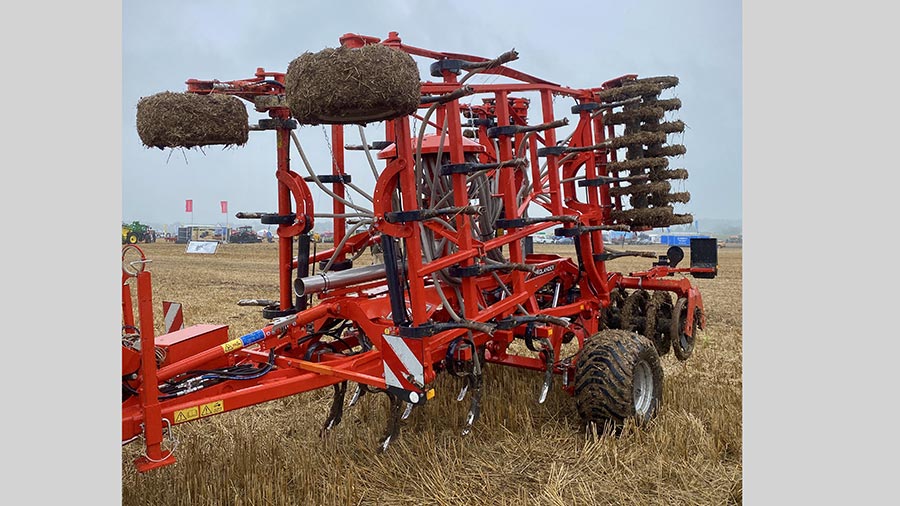
Kuhn Prolander © MAG/Oliver Mark
Owners, and buyers, of Kuhn’s Prolander cultivator now have the option of a seed application kit that extends its use beyond stubble incorporation.
The combination of 1,500 or 2,000-litre front tank, mushroom-shaped TF 1512 distribution head and tine-mounted seed boots adds roughly £30,000 to the list price of a 6m model but, in doing so, offers a quick and easy means of establishing a cover crop.
In this form, the 180mm-wide duck-foot tines typically used for thorough, shallow soil disturbance are replaced by narrower 60mm-wide reversible points.
These are mounted in a staggered arrangement on either the standard 80x12mm vibrating “S” legs or heavier duty 90x13mm versions, the latter primarily for those likely to be working predominantly in more testing, heavy clay soil.
The model on show was kitted out with a double soil-on-soil “U” roller, but there’s also the option of a tube roller and levelling harrows that might better suit lighter soils.
Power requirement is roughly 30hp/m – anywhere between 185hp and 225hp should suffice for the 6m model – to hit the target speed of 12kph.
Ovlac XLander
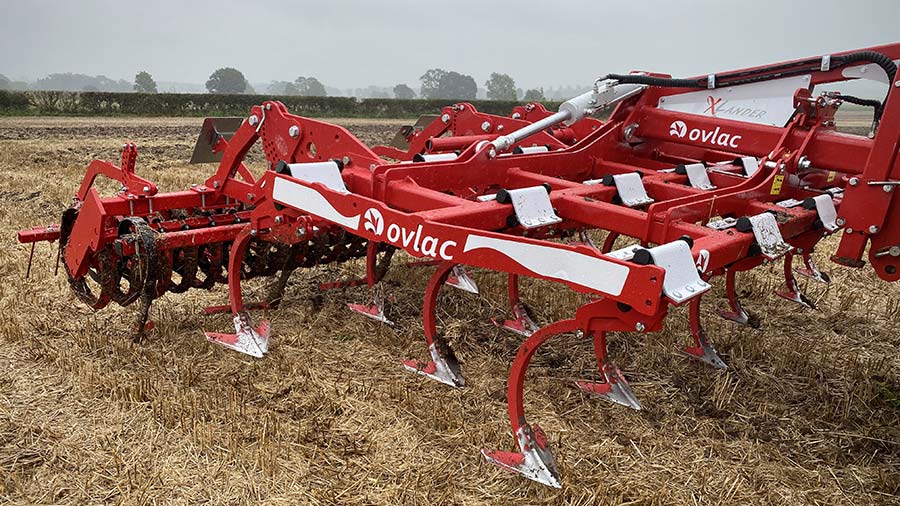
Ovlac XLander © MAG/Oliver Mark
Spanish maker Ovlac has launched its comprehensive range of chisel plough-style stubble cultivators in the UK, following a successful few years selling into other European markets.
With a total of 20 different XLander variants, including rigid and folding mounted versions up to 7.35m and trailed GC models that run from 7.15m to 10m, prospective buyers certainly have no shortage of choice.
Beyond the working width, there’s the option of spreading the tines over two or three rows, the latter seeing each leg spaced at 230mm and marginally offset from its neighbours to improve the flow of material in heavy trash conditions.
The tips can be fitted with 275mm-wide, low-disturbance shallow shares to work 70-150mm deep, or a slightly wider and more aggressive version that will go to 200mm for more intensive mixing of soil, stubble and trash.
For primary or secondary cultivation work, Ovlac recommends a more traditional 60mm-wide curved ripping point that is reversible and available with hard-wearing tungsten carbide tiles.
Impact protection is provided by rubber sausages within the mounting brackets, which allow the tines to move up and down and, to a degree, side to side.
With a trip range of up to 300mm, these offer significantly more upward movement than a sprung system, so the tine should lift clear of any obstacles without affecting the work depth of the implement.
The 4.4m model on show was also fitted with levelling paddles, rear press roller and a following harrow. That package will cost about £25,000 on-farm and it’ll need a tractor of between 130hp and 150hp on the front.
There’s also the option of adding a hopper for catch or cover crops.

